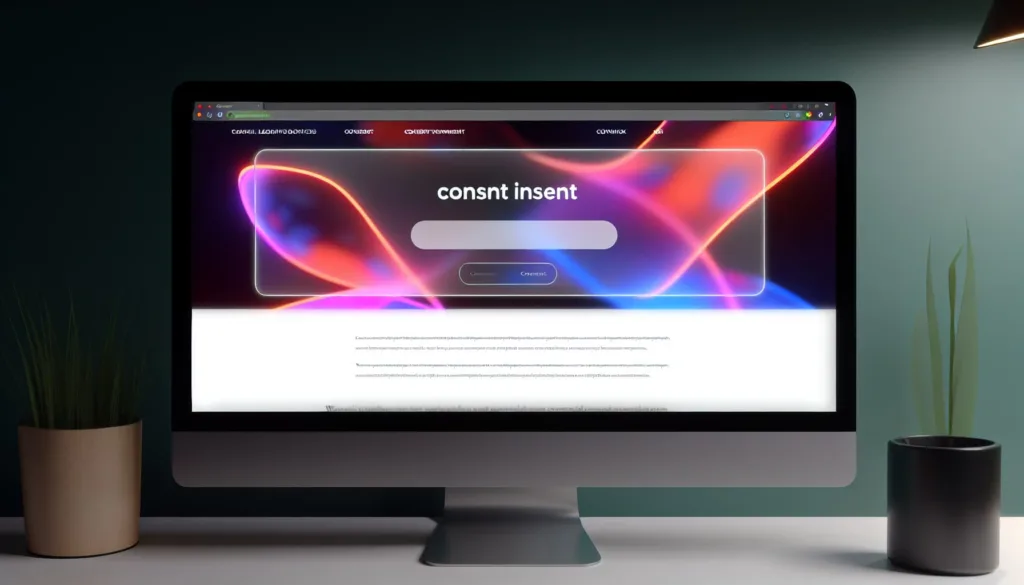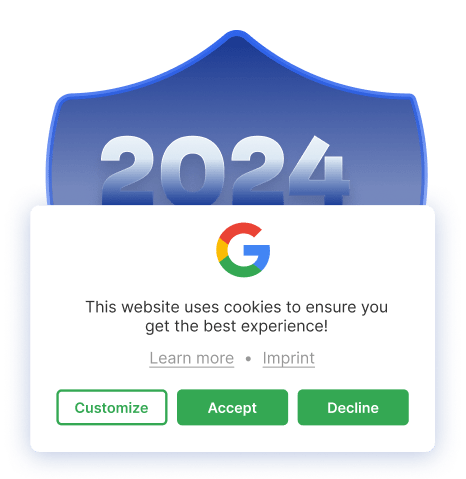Introduction
Google Consent Mode has revolutionized how businesses handle user permissions, aligning website analytics and advertising with privacy regulations like GDPR. With recent updates in 2024, understanding and applying these changes is critical. This article delivers an insightful look at Google Consent Mode’s role in compliance, how to navigate its latest iteration, and the benefits it offers in managing user consent effectively.
Key takeaways
Google Consent Mode v2 introduces new consent signals and parameters for more granular user control over personal data usage and advertising consent, streamlining compliance with GDPR and other data privacy regulations.
The integration of the updated Consent Mode with Consent Management Platforms (CMPs), particularly in e-commerce platforms like Shopify, is critical for managing cookie banners and user preferences and adhering to legal standards.
Conversion modeling is a key component of Google Consent Mode v2, enhancing the accuracy of metrics for non-consenting users through AI, thus maintaining advertising performance visibility despite consent restrictions.
Exploring Google Consent Mode: Definition and purpose

Google Consent Mode is an innovative tool that helps organizations tailor their use of Google tags according to user consent. It modifies the data collection process of Google services per user consent preferences, facilitating smooth analytics and marketing operations in line with each user’s consent choice. By implementing Google Consent Mode, businesses can ensure a strategic asset in the quest for data-driven marketing and GDPR compliance.
As such, Google Consent Mode has become an integral part of any successful marketing strategy, particularly for projects with users from the EEA who use Google Ads.
Understanding the need for user consent
Acquiring user consent is pivotal for legal compliance in data management, as mandated by data privacy regulations like GDPR, ePrivacy Directive, and the Digital Markets Act. These modern data privacy laws empower individuals to have control over their personal data, making the acquisition of user consent a critical business responsibility.
User consent is a fundamental element in maintaining transparency in data collection and processing, providing users the ability to:
Opt-in or out
Have granular control over their data
Reinforce the GDPR’s focus on user autonomy
Extend beyond the EU, impacting all companies dealing with EU citizens’ data. To ensure compliance, obtaining valid user consent is crucial.
How Google Consent Mode enhances compliance
Google Consent Mode is instrumental in helping businesses adhere to data privacy laws, as it modifies Google tags based on user consent. This adjustment includes:
Not reading or writing cookies when denied consent
Offering granular user control over their consent preferences
Standardizing these preferences in a way that consent information is communicated clearly via consent state pings.
With Google Consent Mode v2, Google Consent Mode support is ensured through compliance by providing default consent state, consent settings, and other features, while Google Consent Mode enables these functionalities.
Integrating Google Consent Mode v2 with a Consent Management Platform (CMP) like Pandectes GDPR Compliance app in Shopify is crucial in managing cookie banners and user consent preferences.
Key updates in Google Consent Mode v2

The advent of Google Consent Mode v2 simplifies the journey through the digital landscape by offering a sophisticated method for managing user consent. The updated version introduces two new consent signals, ad_user_data, and ad_personalization, providing instructions to Google’s services on user data usage for advertising.
These new parameters offer more granular user consent by letting businesses specify consent for sending personal data to Google and obtaining user consent for personalized advertising.
New parameters for improved control
To enhance control over data usage, Google added two more parameters in Consent Mode v2: ‘ad_user_data’ for consenting to transfer user data to Google for advertising purposes and ‘ad_personalization’ for consenting to personalized advertising. These parameters operate as downstream instructions for managing user data related to advertising, further refining earlier qualifiers like ‘ad_storage’ for managing advertising cookies.
The granularity of control that these parameters provide allows users to specify their preferences over data use across analytics and advertising.
Advanced and basic implementation options
Google Consent Mode v2 provides users with the choice of either basic or advanced options for implementation. This allows for greater flexibility and customization in managing user consent preferences. The basic implementation means that Google tags will not be activated until users consent, while the advanced implementation can result in tags being triggered prior to user interaction with the consent banner. The advanced mode in Google Consent Mode v2 includes settings like ‘ads_data_redaction’ to prevent the transmission of certain identifiers, providing added privacy control. However, if you are already using consent mode and not engaged in personalized advertising, no action may be necessary regarding the updates.
Implementing Google Consent Mode v2: A step-by-step guide
While implementing Google Consent Mode v2 might appear challenging, a systematic guide can make the process manageable. The implementation process involves:
Determining consent acquisition strategies
Configuring the consent banner
Implementing code changes
Using diagnostic tools in Google Ads for confirmation.
However, verifying the implementation of Google Consent Mode v2 can be ensured through handy tools such as Google’s Tag Assistant, the Network tab in browser developer tools, or a dedicated browser extension.
Choosing the right CMP – Pandectes GDPR Compliance app in Shopify
Selecting an appropriate Consent Management Platform (CMP) is essential to ensure its integration with Google Consent Mode v2. A suitable CMP should allow for the efficient update of user consent status via an ‘update’ command and provide straightforward solutions for recording and pinging user consent status to Google. One such platform is the Pandectes GDPR Compliance for Shopify stores, which integrates with Google Consent Mode v2 and offers built-in integrations and templates for ease of management without any extra coding or manual editing.
Configuring your consent banner

The consent banner’s setup significantly impacts your website’s user experience. The consent banner should be clear and concise and use understandable language, providing options labeled ‘Accept’ and ‘Decline’ to facilitate informed consent decisions.
It’s important to design the consent banner to be:
Non-intrusive yet noticeable to encourage interaction without disrupting the user experience
Clearly communicate the types of cookies and data tracking involved
Record and respect the user’s consent choices
Integrating Google Consent Mode v2 with Google Tag Manager
Integrating Google Consent Mode v2 with Google Tag Manager is a key stage in the implementation process. Google Tag Manager includes consent management features such as a consent initialization trigger, tag settings for consent management, and a Consent Overview page that together facilitate granular consent configurations.
Seamless integration of Google Consent Mode v2 with Google Tag Manager is possible through the use of a CMP like Pandectes GDPR Compliance alongside a community template, eliminating the need for extensive manual coding.
The role of conversion modeling in Google Consent Mode v2

Conversion modeling is a significant feature of Google Consent Mode v2. Conversion modeling estimates the behavior of users who reject cookies based on the interactions of those who consent, providing anonymized analytics data.
Google Consent Mode v2 employs consent signals to fill gaps in conversion tracking caused by non-consenting users, utilizing AI, particularly machine learning, to project conversion behavior patterns from observed user data onto non-consenting users.
Filling gaps in data collection
Conversion modeling in GA4 uses observed data from consenting users to estimate the behavior of non-consenting users. The accuracy of conversion modeling is directly influenced by the quantity and quality of the training data, which includes observed data.
Data gap modeling enabled by Google Consent Mode v2 uses conversion modeling to represent unconsented data in reports.
Improving advertising performance
Conversion modeling in Google Analytics 4 (GA4) enhances advertising performance visibility and accuracy of metrics by utilizing Google Ads conversion tracking. This is achieved by blending observed data with modeled data, facilitating better attribution modeling.
With GA4’s conversion modeling, advertisers gain insights into event data for users who denied consent, aiding in sustaining advertising performance visibility.
Ensuring compliance with global data privacy laws

In the era of digitalization, adherence to global data privacy laws is of utmost importance. Businesses must comply with evolving data privacy regulations to maintain audience access and avoid penalties.
Selecting a Consent Management Platform that lets visitors customize their cookie and data processing consents for advertising or analytics is crucial for GDPR compliance.
GDPR, ePrivacy Directive, and Digital Markets Act
The General Data Protection Regulation (GDPR) governs personal data and establishes data security, transparency, and privacy rights standards. Companies must comprehend and comply with these standards to evade hefty fines.
The ePrivacy Directive mandates the following requirements for electronic communication services:
Informed user consent for the storage or access of information on user devices
Data security measures
Notification to users in the event of data breaches
Limitation on data retention
The Digital Markets Act, in force since May 2023, mandates designated gatekeepers to comply with similar consent provisions as GDPR and ePrivacy Directive for core platform services, ensuring user privacy and consent are maintained in the digital market.
Ongoing adjustments and best practices
In the constantly changing environment of data privacy laws, persistent adjustments and adoption of best practices are vital for compliance assurance. The selected Consent Management Platform should provide transparent and accessible reports on user consent, which is necessary for both compliance and auditing purposes. With the increasing demand for data privacy, consent management platforms have become an essential tool for businesses to maintain compliance. Implementing a consent management solution can further enhance the effectiveness of these platforms.
Businesses must regularly review and update their GDPR compliance measures to meet evolving data privacy standards and avoid significant penalties.
Conclusion
In conclusion, Google Consent Mode v2 is vital for businesses striving to respect user consent while optimizing their marketing strategies. From understanding its purpose and significance to exploring its key updates and implementation process, it’s clear that Google Consent Mode v2 is an essential asset in the quest for data-driven marketing and GDPR compliance. Whether you’re a seasoned marketer or a small business owner, mastering this tool will help you navigate the increasingly complex landscape of data privacy regulations.







